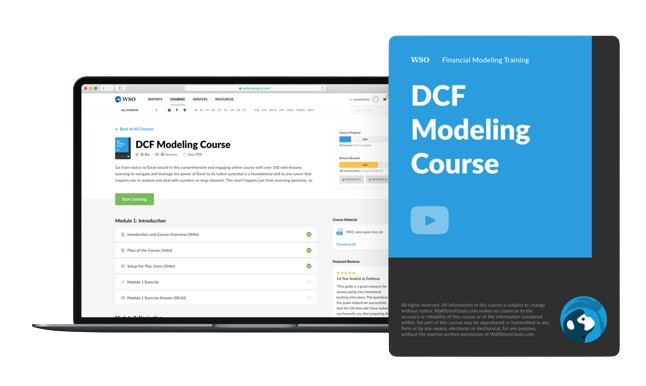DCF Pros & Cons
Usefulness and drawbacks of DCF
What is Discounted Cash Flow DCF analysis?
A discounted cash flow model (DCF) is used to determine the present value of a company or asset depending on the money the company may make in the future.
The calculations are based on the future cash flows of the investment, therefore, it is assumed that the asset will continue to generate money within the evaluated time frame.
The model is used by investors to find the value of an investment today based on how much the investment will return in the future. By doing this, the investor may estimate the returns that are achievable from the investment, taking into factor the time value of money.
Time value of money is the theory that a dollar today is worth more than a dollar tomorrow. This is due to a variety of factors like opportunity cost, inflation, etc.
A discounted cash flow model is useful in a situation where an investor is looking to find an asset to invest in.
For instance, imagine getting paid $10 today. If you invest in a GIC with an annual return of 5%, at the end of the year, the initial amount will have grown to $10.50.
Let us suppose the payment was postponed and received a year later. The present value of the amount is now worth $9.50 (holding all other factors constant), as it can not be invested into the GIC throughout the year.
If the present value is worth more than the cost of the investment, the opportunity should be considered. However, if the present value is lower than the investment cost, the opportunity may not be worthy, or further research may be needed to fully evaluate the investment.
There are estimations that must be put in place when forming a DCF, including:
- Future cash flows
- Discount rate
- Time period
- Ending value of the investment
Determining the discount rate will vary depending on the investment that is being evaluated. The discount rate is determined by factoring in the risk of the investment and the current market conditions.
This model includes a variety of assumptions and estimations, and, therefore, the model is better for some types of investments than others. There are many pros and cons when debating if the model is accurate and if it should be used on a chosen investment.
Key Takeaways
- DCF analysis assesses the present value of a company or asset based on projected future cash flows. The time value of money is a central concept, emphasizing the worth of money today compared to the future.
- They rely heavily on assumptions, making them susceptible to errors and sensitivity to even minor changes. Estimating future cash flows and the discount rate accurately is challenging, potentially leading to flawed outcomes.
- DCF analysis should be used by experienced analysts who are aware of its intricacies and potential pitfalls. It is crucial to cross-verify the results with other valuation methods, such as the Dividend Discount Model and Comparable Company Analysis, to ensure accuracy.
What are the Pros of DCF analysis?
A discounted cash flow model is most accurate and effective when the analyst is confident in the assumptions they are using to create the model.
It takes in a lot of values in order to calculate the intrinsic value of a stock, each of which is based on estimations. For the model to give the most accurate result, these estimations must be as accurate as possible.
Discounted cash flow models can be very helpful, providing analysts, investors, and companies a prediction of whether their future investment will be worthwhile.
The model is used to estimate the future value of a variety of investment and capital projects, as long as future cash flows can be accurately estimated.
These models can be adjusted to provide tailored results for specific scenarios which can help people estimate if a certain project will be possible and profitable.
Pros are:
- Determines intrinsic value of an asset or company
- Very in-depth and detailed calculations
- Includes a vast variety of assumptions about a business
- Does not require comparable companies
- Can be made within Excel
- Helpful for sensitivity analysis
- Helpful for evaluating mergers and acquisitions
- Can help to find the internal rate of return of an asset
What are the Cons of DCF analysis?
Although DCF modeling has many good attributes, it also has its disadvantages. One of the largest concerns is the number of assumptions.
The assumptions made can expose the model to errors, especially when analysts are overly-pessimistic or overconfident in the value of the company.
For it to be accurate, analysts and investors must estimate cash flows and discount rates correctly, which is not easy.
Estimating future cash flows relies on many factors, including current market conditions, market demand, technology, competition, and sudden threats and opportunities, all of which are very difficult to calculate.
If strong assumptions cannot be made, a DCF should not be exclusively relied on. Other valuation models may be better or used in tandem to create the most accurate predictions.
List of Cons are:
- Dependant on assumptions
- Exposed to errors
- Can be very complex
- Sensitive to small changes
- Ignores all other companies
- Hard to estimate the weighted average cost of capital (WAAC)
- Terminal value is difficult to measure and makes up a large part of the calculation
When should discounted cash flow analysis be used?
When deciding to evaluate a company using discounted cash flow, the analyst must be aware of all the advantages and disadvantages to ensure the model fits the company.
Creating it is exceedingly complex and takes a lot of practice to learn. Therefore, it is better to be experienced when trying to create an accurate model.
To make more accurate use of this analysis, it is best to compare the results to those from other intrinsic and relative valuation methods, creating a range of estimates.
Using more than one model, the final decision will be easier to come to, as each method may confirm one another.
Other Valuation Models include:
- Dividend Discount Model
- Comparable company analysis
Read more about stock valuation here.
If the other valuation methods give values that are each different, it shows that there may have been an error within one of the models and that the assumptions should be re-evaluated.
In most scenarios, the value derived from a DCF analysis is within the range of the current price, which can also confirm that the value is accurate. If the value is way far off, there is likely a significant error somewhere in the calculations.
Therefore, when done correctly, discounted cash flow models can be very helpful for investors trying to figure out which investments will be profitable. However, the models are complex and hard to get right.
A lot of estimations are taken into consideration. A significant portion of these values are difficult to estimate, possibly leading to inaccurate results.
In the end, these models are best used by experienced analysts who also compare them to other models and back up their assumptions.
DCF Analysis FAQs
Discounted cash flow analysis is a valuation method used to estimate the value of an investment based on its future cash flows. It helps analysts evaluate the value of an investment today by estimating how much it may return in the future and discounting those future inflows to their present value.
The main advantage for analysts and investors is that, if done correctly, the assessment can determine if a future investment is worthwhile. As a result of due diligence, one can gain an advantage and use their findings to make huge profits.
The main disadvantage is that the model is very difficult to get correct. A discounted cash flow is based on estimations. For the model to be useful, one must estimate the asset’s discount rate and future cash flows correctly, both of which are very complex.
Discounted cash flows and net present value are different but can be used together to help make a decision. The two tools both help asses future cash flows. A DCF tells an investor the future value of an investment and how long it would take to reach the desired result.
NPV is a component of discounted cash flow. It compares the value of money today to the value of money in the future, based on the idea that a dollar today is worth more than a dollar tomorrow.
Net present value takes in one's inflows and outflows to see the profits of an investment, and if the investment is worth the cost.




or Want to Sign up with your social account?